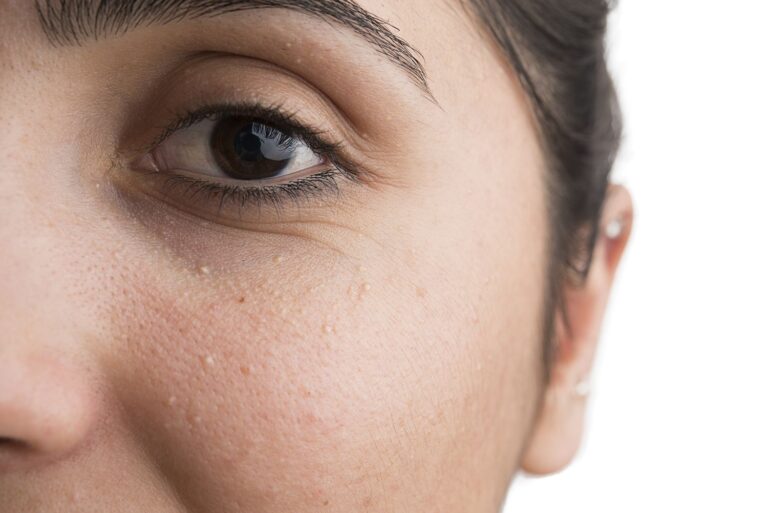Milialar, frequently pluralized as miliaria, are those tiny, white bumps that can pop up on your face, every so often seemingly out of nowhere. While they’ll be a nuisance cosmetically, they’re typically innocent. But what precisely are those little milia, and why do they decide to soak up the house for your skin? This article delves into the world of miliaria, exploring their reasons, types, and how to excellently manage them.
Shedding Light on Skin Cells: Understanding Milia Formation
Our pores and skin is a constantly renewing canvas. New pores and skin cells are produced deep in the layers, pushing older cells toward the floor. Normally, these older cells shed away not noted, revealing the clean layer. However, now and then this process gets disrupted, mainly due to the formation of milialar.
Milialar gets up when keratin, a protein that makes up the outer layer of our skin, gets trapped below. This trapped keratin bureaucracy is a small, difficult cyst, acting as a white or yellowish bump at the pores and skin. Milia are normally smooth and dome-fashioned, measuring only some millimeters in diameter.
A Tale of Two Types: Primary vs. Secondary milialar
While milia might also look like a uniform phenomenon, there are simply essential sorts: number one and secondary.
Primary milialar: These are the most unusual type, commonly performed on the faces of newborns and young babies. Their idea is that it is a result of the immature development of the skin and its losing mechanisms. Thankfully, number one milia are generally transient and regularly disappear on their personal within a few weeks.
Secondary milia: These milia can broaden at any age and are caused by elements that disrupt the regular pores and skin-shedding system. Some not-unusual culprits encompass:
Sun damage: Chronic solar publicity can thicken the outer layer of skin, making it harder for trapped keratin to break out.
Skin injuries: Blisters, burns, or other wounds that heal can go away scar tissue, doubtlessly trapping keratin underneath.
Cosmetic methods: Certain cosmetic tactics, like dermabrasion or laser remedies, can damage the pores and skin and boom the danger of secondary milialar.
Topical medicines: Long-time period use of steroid creams or corticosteroids can now and again make a contribution to milia formation.
Where Does milialar Like to Lurk? Favorite Spots on the Body
Milialar has a preference for positive areas of the body, specifically those with sensitive skin.
The most not unusual locations for milialar include:
Face: The cheeks, eyelids, and brow are the prime actual estate for milia, specifically the number one milia in newborns.
Genitals: Milia can seem at the genitals, both male and woman, even though this is much less common.
Torso: The higher chest and lower back may be affected, particularly in instances of secondary milia.
Should You Be Worried? The Harmfulness of milialar
The excellent information is that milia are typically taken into consideration as innocent. They do not motive pain or itching, and they don’t pose any health dangers. However, a few human beings may additionally find them cosmetically bothersome, specifically after they appear on the face.
If you have got milia and they are inflicting you misery, there are methods to manipulate them. However, it is important to consult a dermatologist earlier than trying any at-domestic removal techniques. Improper milia extraction can lead to scarring or contamination.
Befriending Your Skin Again: milialar Management Options
While milialar may not be a medical difficulty, there are alternatives for individuals who want to limit their appearance. Here are some procedures to do not forget, continually underneath the steerage of a dermatologist:
Professional extraction: Dermatologists have the information and tools to safely take away milia through the usage of sterile strategies. This is the only manner to remove milia, but it can require more than one period depending on the severity.
Exfoliation: Gentle exfoliation can help get rid of lifeless skin cells that are probably contributing to milia formation. However, be cautious not to over-exfoliate, as this will worsen the pores and skin and get worse the hassle.
Retinoids: Topical retinoids, derived from nutrition A, can help stimulate skin mobile turnover. This can be useful in stopping new milia formation, despite the fact that existing milia might not reply as nicely.
Chemical peels: Chemical peels may be used to dispose of the pinnacle layer of pores and skin, doubtlessly assisting in disposing of milia. However, this is an extra competitive method and ought to be accomplished by using a dermatologist.
Patience is Key: The Natural Course of Milia
It’s crucial to not forget that, mainly for primary milia in newborns, those bumps often disappear on their very own within a few weeks. Resist the urge to choose or squeeze at them.
Conclusion
Milialarcan be tiny, but they are able to leave a substantial mark on your skin. While they are commonly harmless, the desire for a smooth, clean complexion is understandable. By knowing the reasons and forms of milia, you can make knowledgeable decisions approximately managing them.
If you have got milia and they may be bothering you, consult a dermatologist. They can check your precise situation and suggest the most suitable course of motion. Remember, endurance is regularly key, especially with the number one milia. In many cases, those little troublemakers will fade away on their very own.
For people with secondary milia, addressing the underlying motive, along with sun harm or incorrect skincare practices, can help prevent destiny outbreaks. Ultimately, with a touch of expertise and the proper method, you can hold your skin milia-loose and sparkling with health.
